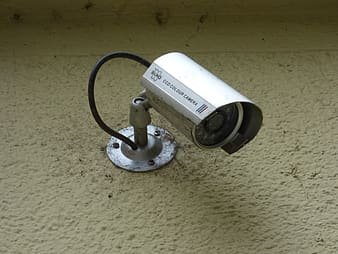Table of Contents

gray-bullet-security-camera-thumbnail
The international law precisely regulates the modalities of using a surveillance camera at work. The aim of these measures is to strike the right balance between the legitimate reasons that push an employer to install surveillance cameras in a professional environment and the indispensable respect of employees’ privacy. Find out everything you need to know about surveillance cameras in this guide.
Surveillance camera at work: a safety issue
Why do companies install security camera systems in the workplace? The installation of cameras meets a protection requirement that concerns both goods and people. For example, camera surveillance in a store is used to stop thieves from robbing the shelves, but also to deter criminals who might threaten the safety of staff.
The purpose is similar in offices, home and schools, reception areas open to the public or professional establishments, where the presence of a surveillance camera is intended to reduce the risk of inappropriate behavior or damage. Problem: These legitimate reasons sometimes lead to abuse, with companies using their cameras to monitor their employees, control their productivity, or film areas dedicated to private use such as changing rooms or rest areas.
Around the world, the use of surveillance cameras in a professional environment is therefore precisely regulated by the labor code, the penal code, and the civil code. Control of compliance with these obligations is primarily the responsibility of the regulations Commission in the individual countries around the world.
Cameras at work: yes, but with respect for privacy.
The regulations are concerned with video surveillance as a whole. First, they specify the conditions under which it is possible to operate a camera. It then considers the question of access to the filmed images and their storage period.
Installing a camera at work: the rules to follow
What does the law say? It authorizes the installation of surveillance IP camera at the entrances and exits of buildings, as well as on the main internal traffic routes. However, it prohibits the filming of employees at their workstations, particularly in offices, in order to guarantee them a certain degree of privacy. Cameras must also be aimed away from toilets, break areas and union premises.
However, there are exceptions. For example, a company is allowed to film a cashier employee using a surveillance camera. It can also install a camera to monitor valuable goods by filming the employees handling them. In this case, however, it must adjust the location of the camera to film primarily the valuables and keep the pressure on the people working in the field to a minimum.
Surveillance in a professional environment: information and access to images
It is forbidden to film people in the workplace without their knowledge: employees and the public must be informed of the presence of a surveillance camera. In some cases, the company must seek the approval of employee representatives before implementing any video surveillance.
In addition, access to images captured by a surveillance camera in the workplace is restricted to authorized personnel only. Finally, the company must define a maximum retention period for the images from its cameras.
Employees who believe they are victims of abusive surveillance can turn to the labor inspection services to file a complaint and request a check.
Video surveillance and remote monitoring
The rules described here apply when the surveillance cameras are programmed to continuously film the workplace, but the operation is different in the context of the remote monitoring offered by Verisure. With remote monitoring, camera-equipped motion detectors and optional connected surveillance cameras are programmed to automatically capture a series of images when the alarm system detects an intrusion attempt. When the alarm is not triggered, remote surveillance does not pose any threat to the privacy of the occupants of the premises concerned. On the other hand, a classic video surveillance scenario is used if the user decides to use his equipment to control the premises outside of the situations linked to the triggering of the alarm.
